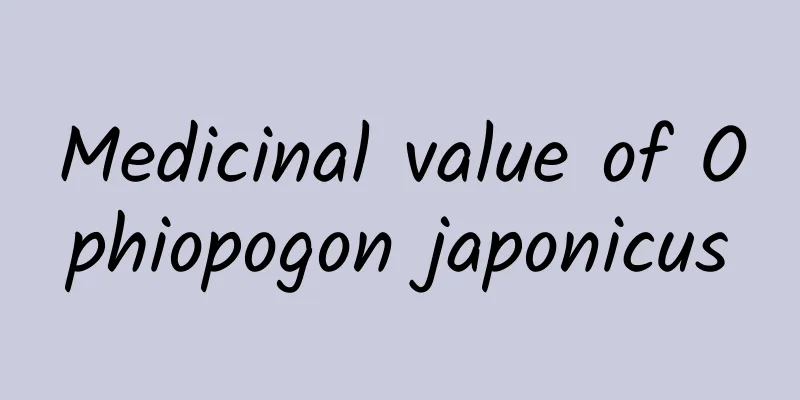Medicinal value of Ophiopogon japonicus

|
When it comes to the medicinal value of Ophiopogon japonicus, many people don’t know it, but for people in related professions, they are relatively familiar with the medicinal value of Ophiopogon japonicus, because Ophiopogon japonicus is often used as a medicine. In fact, Ophiopogon japonicus should be said to be a herb in essence. Many of our Chinese herbal plants usually have medicinal value, and Ophiopogon japonicus is no exception. The medicinal value of Ophiopogon japonicus lies in its roots, so its tuberous roots can often be called a Chinese medicinal material. However, due to the decline of traditional Chinese medicine in recent years, few people sign up to study Chinese medicine now, so few people know about Ophiopogon japonicus and its medicinal value. Let’s talk about the medicinal value of Ophiopogon japonicus. Medicinal value For the treatment of angina pectoris caused by coronary heart disease, take 45 grams of Ophiopogon japonicus, add water and boil it into 30-40 ml, take it in divided doses for 3-18 months. It has a certain effect on relieving angina pectoris and chest tightness. It nourishes yin and produces body fluid, moistens the lungs and relieves cough. It is used for symptoms such as lack of body fluid, thirst, dry cough and hemoptysis due to lung and stomach yin deficiency; palpitations and easy fright due to heart yin deficiency; and damage to body fluid by heat in the late stage of febrile disease. For the treatment of chronic gastritis, take 9 grams each of Ophiopogon japonicus and Astragalus membranaceus, 10 grams each of Codonopsis pilosula, Polygonatum odoratum and Polygonatum sibiricum. Decoction in water, 1 dose per day. It is effective for those with insufficient stomach yin. To treat summer sweating and collapse, take 10g each of Ophiopogon japonicus and Ginseng and 6g of Schisandra chinensis, decocted in water, 2 doses per day. It is effective for exhaustion due to sweating, palpitations, low blood pressure, excessive sweating, thirst, fatigue and weakness (Editor's note: this recipe was created by Li Gao, a famous doctor in the Jin Dynasty. The recipe is called "Shengmai San" and has been made into Shengmai oral liquid). To treat intestinal constipation, take 15 grams each of Ophiopogon japonicus, Rehmannia glutinosa, and Scrophularia ningpoensis. Decoction in water, 1 dose per day. It has the effect of moistening the intestines and promoting bowel movements and is used for dry stools. It nourishes yin and produces body fluid, moistens the lungs and clears the heart. It is used for dry cough due to lung dryness, cough due to consumptive tuberculosis, thirst due to loss of body fluid, restlessness and insomnia, internal heat and thirst, dry intestines and constipation, diphtheria due to pharyngitis For the treatment of diabetes, take 30 grams of Phragmites australis, 15 grams of Ophiopogon japonicus, and 12 grams of Anemarrhena asphodeloides. First boil over low heat for 30 minutes, filter out the decoction, add 500 ml of water to the residue, bring to a boil over high heat, then simmer over low heat for 20 minutes, remove the residue and take the juice, mix the two decoctions and take one dose daily. It is used for diabetic patients with thirst, dry throat, polydipsia, restlessness, or low fever, red tongue, and thin and rapid pulse. For the treatment of acute and chronic bronchitis, take 9 grams each of Ophiopogon japonicus, Asparagus cochinchinensis, Anemarrhena asphodeloides, Fritillaria cirrhosa, and Stemona japonica, and 12 grams of Adenophora scabra. Decoction in water, 1 dose per day. This prescription is suitable for patients with acute and chronic bronchitis presenting with yin deficiency and dry cough. Precautions Do's and Don'ts: People with spleen and stomach deficiency, diarrhea, phlegm and dampness in the stomach, and cough caused by sudden cold should not take it. Storage: Store in a cool, dry place away from moisture. It turns out that Ophiopogon japonicus has so many medicinal values. I believe many professionals are unaware of this. Therefore, knowing the medicinal value of Ophiopogon japonicus, everyone can pay more attention to traditional Chinese medicine in the future, because traditional Chinese medicine is the foundation of our Chinese medicine, and the uses of traditional Chinese medicine are much better than Western medicine. Therefore, everyone should learn more about Chinese medicinal materials in the future, which will also be beneficial to everyone's future life. |
<<: The efficacy and function of Ma Ren Wan
>>: What is Ophiopogon japonicus
Recommend
In the era when there were no heating devices, people could only rely on drilling wood to make fire to keep warm? There are also "solar lighters"!
It's been really cold these days! We all feel...
World Dance Day | Beware! This "dangerous move" can cause disability, but many people actually think it is good for children.
Today is World Dance Day . In recent years, dance...
The efficacy and function of spirea root
Spiraea root is a commonly used medicinal materia...
The "Four-Hour Sleep Method"? Is it really reliable to imitate animals in sleeping?
"Turning around the red pavilion, lowering t...
What are the medicinal values of ginseng?
Ginseng is a very precious medicinal material and...
The efficacy and function of piercing grass
For the Chinese medicinal material such as the he...
How long does it take for Chinese medicine to be effective for hair growth?
Due to high work pressure, heavy study burden, an...
Can Codonopsis be eaten raw?
Codonopsis pilosula is a food with great medicina...
Undrinkable "milk" + seafood waste = national treasure?
The Zhejiang Provincial Museum houses several anc...
Can Panax notoginseng be eaten?
The herb Panax notoginseng, as a traditional Chin...
The efficacy and function of tiger eye
Tiger's eye is a medicinal material that can ...
In order to stop having nightmares, I tried to make up a "good ending" for it, and it actually worked!
Generally speaking, if you have a good night'...
To prevent “egg head rot”, who is the “flower protector” of Songhua preserved eggs?
Songhua preserved eggs have a unique flavor and a...
What are the effects of Panax notoginseng liver-nourishing tea?
Drinking tea is a very fashionable way of maintai...
Danger! Don’t do this when your roof is moldy
The most frustrating thing about humid weather is...









